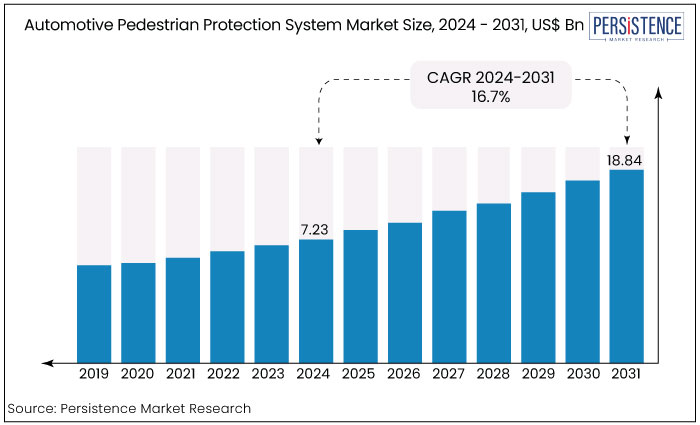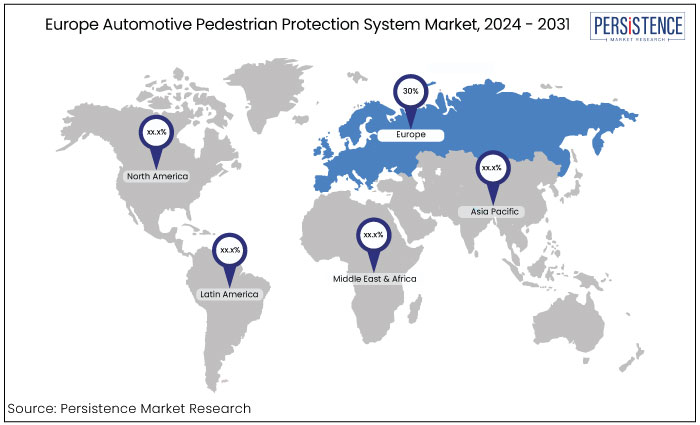Industry: Automotive & Transportation
Published Date: October-2024
Format: PPT*, PDF, EXCEL
Delivery Timelines: Contact Sales
Number of Pages: 190
Report ID: PMRREP34879
The automotive pedestrian protection system market is estimated to increase from US$ 7.23 Bn in 2024 to US$ 18.84 Bn by 2031. The market is projected to record a healthy CAGR of 14.7% during the forecast period from 2024 to 2031. Market growth is primarily fueled by heightened safety concerns and government initiatives aimed at reducing pedestrian fatalities in traffic accidents, which account for nearly 25% of all road traffic deaths globally according to the World Health Organization (WHO).
European Union’s stringent safety regulations such as Euro NCAP's five-star safety rating system, which includes pedestrian protection as a key criterion aid the European regional market. As a result, European automakers are integrating active and passive PPS systems such as external airbags, sensors, and automatic braking systems to comply with regulatory standards and enhance vehicle safety.

Key Highlights of the Market
|
Market Attributes |
Key Insights |
|
Automotive Pedestrian Protection System Market Size (2024E) |
US$7.23 Bn |
|
Projected Market Value (2031F) |
US$18.84 Bn |
|
Global Market Growth Rate (CAGR 2024 to 2031) |
14.7% |
|
Historical Market Growth Rate (CAGR 2019 to 2023) |
14.5% |
|
Region |
Market Share by 2024 |
|
Europe |
30% |
Europe dominates market with a significant share due to stringent safety regulations, a high focus on reducing pedestrian fatalities, and an increasing emphasis on vehicle safety standards.
The European New Car Assessment Programme (Euro NCAP) plays a crucial role, as it mandates advanced safety features, including pedestrian protection systems, in vehicles. The regulatory framework has driven automobile manufacturers to integrate PPS in vehicles to comply with safety norms and improve their safety ratings.
The growing demand for luxury and electric vehicles, which often include advanced safety systems as standard also contributes to Europe’s market dominance. Another key factor supporting Europe’s leadership is its highly developed automotive industry with leading players like Volkswagen, BMW, and Daimler leading innovation in vehicle safety technologies.
The presence of numerous research and development centers focusing on automotive safety, combined with consumer awareness regarding vehicle safety features further solidifies Europe as the leading region in the automotive pedestrian protection system market.

|
Category |
Market Share by 2024 |
|
Type - Automatic Braking & Collision Avoidance |
45% |
Based on type, the market is divided into automatic braking & collision avoidance, brake assist, external airbags, and pop-up bonnets. Among these, the automatic braking & collision avoidance dominates the market.
Automotive Pedestrian Protection Systems are designed to automatically detect pedestrians in the vehicle's path and initiate braking or evasive manoeuvres to avoid collisions. The said technology holds the largest share of the market, accounting for over 45% of the total market revenue.
The dominance of automatic braking & collision avoidance systems can be attributed to the increasing integration of Advanced Driver Assistance Systems (ADAS) and the growing trend toward vehicle automation.
Many global safety regulations, like those from Euro NCAP and NHTSA (National Highway Traffic Safety Administration), require the inclusion of active safety systems like automatic braking to ensure pedestrian safety. As a result, this system has become a standard feature in most new vehicles particularly in luxury, electric, and premium vehicles.
|
Category |
Market Share by 2024 |
|
Component - Sensors |
40% |
In terms of component, the market is classified into sensors, actuators, control unit and cameras. Among these, sensors dominate the market due to their critical role in detecting pedestrians and triggering real-time safety responses. The dominance of sensors can be attributed to the increasing integration of Advanced Driver Assistance Systems (ADAS), which rely heavily on various sensors, including radar, ultrasonic, infrared, and LiDAR.
Sensors continuously monitor the vehicle’s surroundings, detecting pedestrians and other obstacles, and provide data to the control unit to initiate protective actions like automatic braking or deploying external airbags. As pedestrian safety becomes a priority, automakers are integrating more advanced and accurate sensor technologies to ensure timely responses and minimize accident risks.
A pedestrian protection system is employed to safeguard pedestrians during abrupt collisions, hence minimizing injury. This system is equipped with sensors for pedestrian collision detection and an airbag control unit capable of activating the actuators to elevate the engine hood.
Upon activation of the device, the rear portion of the bonnet elevates, and the driver is alerted by an automatic alarm. Systems such as popup hoods, speed airbags, and flexible air tubes are employed to enhance pedestrian safety during abrupt incidents.
The diverse systems primarily focus on safeguarding pedestrians' heads and limbs. Furthermore, according to the fundamental definition, the vehicle-pedestrian safety system sector relies solely on sales and recent advancements in active hoods and external airbags to save pedestrians from collisions.
The automotive pedestrian protection system (PPS) market experienced steady growth from 2019 to 2023, driven by increasing regulatory requirements for vehicle safety and rising consumer awareness of pedestrian safety.
Governments and organizations particularly in regions like Europe and North America, mandated the integration of pedestrian protection systems through programs like Euro NCAP and NHTSA significantly influencing active safety systems such as automatic braking, collision avoidance, and external airbags. Automakers responded by integrating these systems, especially in high-end vehicles, which helped the market to expand at a CAGR of around 14.5% from 2019 to 2023. However, the adoption was more prominent during this period in developed regions with stringent safety regulations.
Post-2024, the PPS market is expected to grow more accelerated driven by advancements in autonomous driving technology and the broad adoption of Advanced Driver Assistance Systems (ADAS).
The market is projected to record a CAGR of over 14.7% during the period from 2024 to 2031 as both developed and developing regions push for high safety standards. Countries in Asia-Pacific, including China and India are expected to become significant contributors due to government mandates for safety technologies and a surge in vehicle sales.
The rise of electric vehicles and autonomous driving systems will further boost the demand for PPS, as these vehicles increasingly incorporate pedestrian protection features.
Increase in The Incidence of Road Accidents Globally
The World Health Organization (WHO) fact sheet indicates that road traffic injuries are the primary cause of death for individuals aged 15 to 29, resulting in 1.25 million fatalities annually due to road accidents. Moreover, 90% of global road fatalities transpire in poor and middle-income nations despite these countries possessing around 54% of the world's autos.
Traffic accidents account for 3% of most countries' gross domestic product (GDP). These considerations lead to heightened demand for automobiles equipped with autonomous emergency braking systems (AEBS) and pedestrian protection systems to ensure the safety and security of the vehicle, driver, and pedestrians.
Vehicle accidents inflict significant economic detriment on individuals, their families, and governments. Consequently, there is an increasing demand for safety measures in automobiles. Numerous automotive manufacturers have implemented safety measures to address consumer demands.
The automotive pedestrian protection system market is propelled by the increasing demand for vehicle safety features, enhancing the need for pedestrian protection systems to prevent road accidents.
The need for safety features including parking assistance, collision avoidance systems, lane departure warnings, tire pressure monitors, airbags, and telematics is anticipated to rise due to the growing incidence of road accidents globally.
The Association of Safe International Road Travel (ASIRT) reports that over 1.3 million individuals perish annually in road accidents globally, averaging 3,287 fatalities daily. Consequently, there is a heightened demand for safety measures in automobiles.
Automobile manufacturers have implemented safety measures to address consumer demands. Moreover, diminished visibility circumstances, such as fog, often result in multiple vehicle collisions with severe repercussions.
The Radar and Lidar sensors employed for pedestrian recognition alert the driver when the vehicle is at risk of colliding with an object ahead. Hence facilitating collision avoidance, especially in low visibility situations. Such advanced technology enhances market expansion to some extent.
Governmental mandates for safety ratings and anti-crash initiatives from many nations are fostering awareness of safety standards in vehicles. These elements are important for driving the automobile pedestrian protection system market opportunities in the near future.
High Cost of Integration & Maintenance
The substantial expenses related to the installation of applications like external airbags and highly accurate collision avoidance sensors in vehicles impede the expansion of the automotive pedestrian protection system market, as this aspect results in increased vehicle costs.
The introduction of premium amenities in vehicles results in increased costs for consumers due to hardware and components. Furthermore, the maintenance of the vehicle is challenging and necessitates proficient technicians due to the numerous electronic components and sensors. Consequently, these factors are anticipated to significantly influence the expansion of the automobile pedestrian protection systems market.
Integration of Pedestrian Protection Systems in Autonomous and Electric Vehicles (EVs)
The growing adoption of autonomous vehicles (AVs) and electric vehicles (EVs) presents one of the most significant opportunities for the PPS market. Autonomous vehicles, which rely on advanced sensors, cameras, and radar technologies, require robust pedestrian protection systems to ensure safe and collision-free operation, especially in urban environments.
Pedestrian detection and avoidance capabilities are essential components of Advanced Driver Assistance Systems (ADAS) in AVs, making PPS a critical feature. Pedestrian safety is even more important for electric vehicles due to their quieter operation, which increases the risk of pedestrian accidents in busy cities.
Governments in regions like the EU and North America have started mandating the inclusion of pedestrian safety technologies in EVs. Integrating automatic braking and collision avoidance systems in EVs is a transformative opportunity that aligns with the growing demand for greener and safer transportation. As the adoption of EVs and AVs accelerates, the PPS market is positioned to grow substantially.
The competitive landscape of the automotive pedestrian protection system (PPS) market is characterized by a mix of established automotive players and technology firms driving innovation.
Key market players include Continental AG, Robert Bosch GmbH, Denso Corporation, ZF Friedrichshafen AG, and Autoliv Inc., which dominate the market by offering a range of advanced pedestrian safety solutions, including sensors, control units, and airbag systems. Companies focus on integrating pedestrian detection systems into Advanced Driver Assistance Systems (ADAS), bolstered by partnerships and acquisitions to strengthen their portfolios.
Increasing collaborations with automakers particularly in the autonomous and electric vehicle sectors, are key strategies for gaining a competitive edge. Regional companies are also making strides, especially in Asia-Pacific with growing demand in emerging markets like China and India.
Recent Industry Developments in the Market
|
Attributes |
Details |
|
Forecast Period |
2024 to 2031 |
|
Historical Data Available for |
2019 to 2023 |
|
Market Analysis |
US$ Billion for Value |
|
Key Regions Covered |
|
|
Key Market Segments Covered |
|
|
Key Companies Profiled in the Report |
|
|
Report Coverage |
|
|
Customization & Pricing |
Available upon request |
By Type
By Component
By Vehicle Type
By Region
To know more about delivery timeline for this report Contact Sales

The market is estimated to be valued at US$18.84 Bn by 2031
The market is anticipated to exhibit a CAGR of 14.7% over the forecast period.
Some of the key players in the market are VALEO, Mobileye, Audi AG, are some of the key players.
European is the dominant regional market automotive pedestrian protection system.
Automatic Braking & Collision Avoidance system type leads the market with major market share.